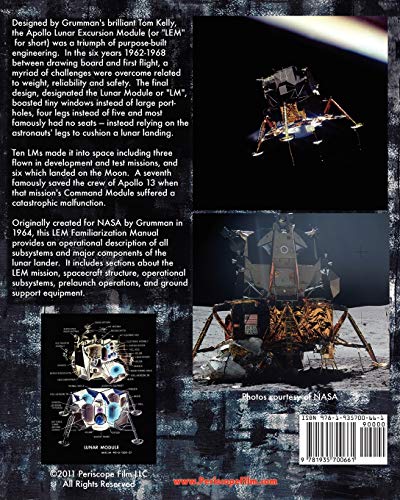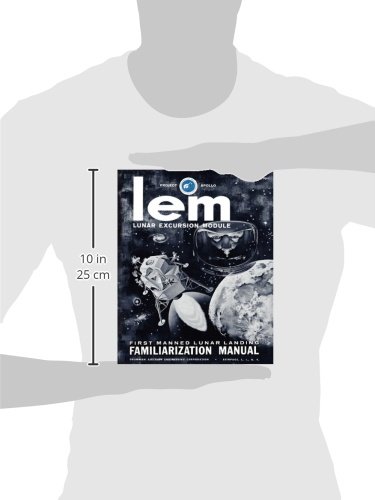



LEM Lunar Excursion Module Familiarization Manual
J**E
Buyer Beware - This may not be what you think
This manual is a fascinating document for anyone interested in the details of the development of the LM. The LM that finally flew just three years later was a very, very different vehicle than the one described in this manual. So if you are looking for a book that describes the Lunar Module that landed on the moon, this is not the book for you. On the other hand, if you want a detailed description of the early design of the LM then this is a gold mine of information. This book has information on the early design of the LM that I haven't seen in print anywhere else.Here are some of the major differences that I spotted in my first casual pass through the book:The LEM Fam Manual describes an electrical system powered by fuel cells, with all the cryo storage and such. The LM that landed on the moon was powered by batteries and didn't have the hydrogen cryo storage system at all and the oxygen cryo system was much simpler. The Fam Manual describes an Ascent Stage with two docking hatches. The LM that landed on the Moon had one, located on the top of the cabin. The Fam Manual describes both descent engine designs; one throttled by helium injection and one that used mechanical throttling, and of course only the mechanically throttled design actually flew. The Fam Manual describes lunar surface operations as being carried out by a single astronaut, while of course both actually got out of the LM to walk on the Moon. All the crew hardware and space suits described in the Fam Manual are early designs that changed dramatically by the time of the first landing in 1969. The displays and controls in the Fam Manual bear almost no resemblance to those on the LMs that landed on the moon.So there is a wealth of rare information here, but this book definitely does not describe the Lunar Modules that landed on the Moon.
K**N
Space nerd bliss
Original detailed design specifications and drawings of the lander from 1964 showing how advanced the early design was, as so little was changed. It details engine, reaction control, life support, power and avionic systems and really everything else. This would be a must read for those building the next landers. It may be done differently but every detail listed would have to be addressed next time.
P**L
Interesting
Published in 1964 according to the inside title page. It was interesting to see this earlier version of the LEM. I noticed it was still called the LEM first and then saw the round front hatch, which was subsequently changed to a square shape. I would recommend this with Tom Kelly's book "Moon Lander" as a companion because, by itself, it doesn't explain the "why" of things.
H**S
Very high quality reprint of an original. The panel ...
Very high quality reprint of an original. The panel pictures, while perhaps reduced from what may have been foldouts in the original, are nevertheless very clear. Contrasted with the same thing in the "Apollo Spacecraft Familiarization" manual which covers the Command Module in the same detail, the reproduction of the LEM manual is sharp and clear. The 8x10 size is a plus too.
T**X
LM information is still available .
Great reference material. Can pick it up and start reading anywhere !!
A**R
Elegant Solution
With the retiring of the US Space Shuttle fleet (STS), it seems only appropriate to examine one of the most elegant spacecraft, manned or unmanned, that was ever created and successfully flown to, and lifted off from, another planetary body. Harken back to when the little Agency that could, NASA, actually was allowed to do its job.
D**N
Must have
Wow what a great book. recommend it highly if you are into the technical aspect of the lunar module. Most books are full of fluff (for lack of a better term). This reprint of Grummans manual is quite technical which is what I yearned for since i am an apollo geek! If you too want the nuts and bolts of the lunar module this, from the manufacturer of the Lunar Module, can't be beat.
P**N
some mistakes on this LM manual
I think this book should be checked before it's publication !as matter of fact I found 2 big mistakes in itfirst mistakeaccording to this manual fuel cells have been installed in LM ascent stageit is not truenever any fuel cells were never flown in any unmanned or manned LMsonly very early in the design phase fuels cells were mentionnedbut they will be removed long time before the first flightsecond mistakethe landing radar skecth is not true the shape the design and the location are not true in the drawing LMA 790-1 sheet 2-7
M**E
Grumman LEM Owner's Manual
Comprehensive content including: seats, suit, life support, controls. How to fly, where the bonnet/hood release is, thrusters, landing pads, sensors...everything the pilot needs to understand this no-nonsense craft. All reproduced in black ink from the original Grumman tech manual with plenty of photos and diagrams. Not so chunky (decent paperback novel thickness) but packed with fascinating information and practically unknown insights into how the equipment and facilities influenced what these brave men were able to achieve in the unforgiving lunar and space environments. A great document for engineers, designers and anyone interested in the 'transitional' aerospace technology of the 1960s. A functional, concise document that makes you wonder how we'd do it differently today. Most of the problems were solved and designs produced by guys who grew up in aircraft/marine/military engineering without any digital tech to hand. As I read I started to think about the organisational structure required to get humans on the moon and back (politically driven or not) and was freshly respectful of the men and women who delivered the dream.
J**Z
A snapshot in time
This manual was originally published in 1964 and is therefore not accurate. It describes an early iteration of the dESign with circular hatch on the front of the LEM and fuel cells (changed for batteries in the final design). The section on exploration of the lunar surface suggests that only one astronaut at a time would be working outside the LEM.A fascinating read nevertheless .
P**L
A treasure of informations. A lot of diagrams.
It’s a bible for the fan’s space history and the Apollo program. Be careful, the version of the LEM described in this book is not the version of Apollo 11 and following missions, It is the early version, without the fuel cell and with the circular hatch for exemple.
A**R
As advertised.
Reviewed 6 years ago.Time to update!
P**A
Poco specifico
E' vero. Si tratta del "Familiarization Manual".Purtroppo mi aspettavo di più (anche se le recensioni d'oltre oceano non facevano presagire qualcosa di meglio).Insomma, è più un oggetto da collezione per l'appassionato.
Trustpilot
1 month ago
1 day ago